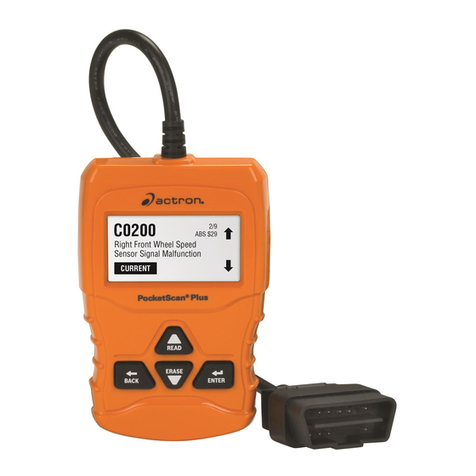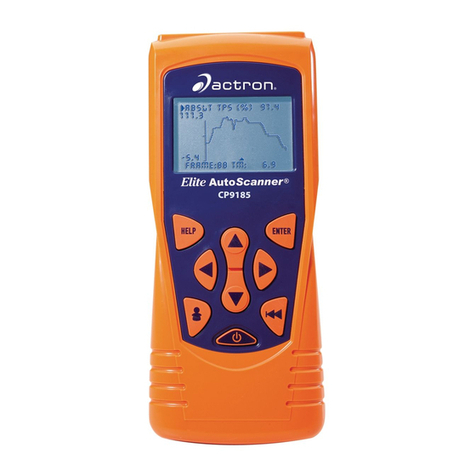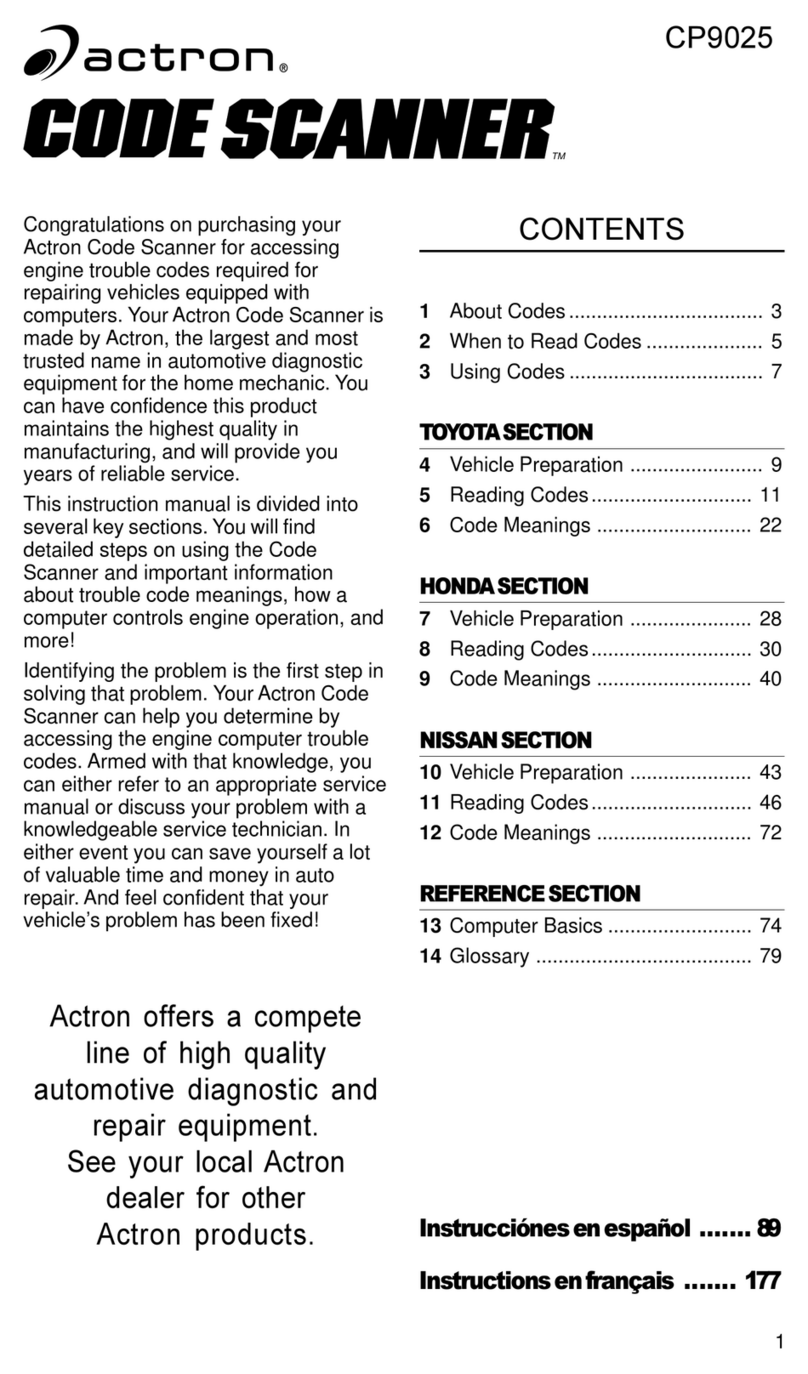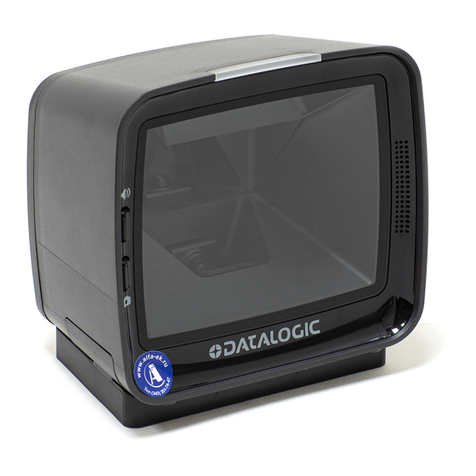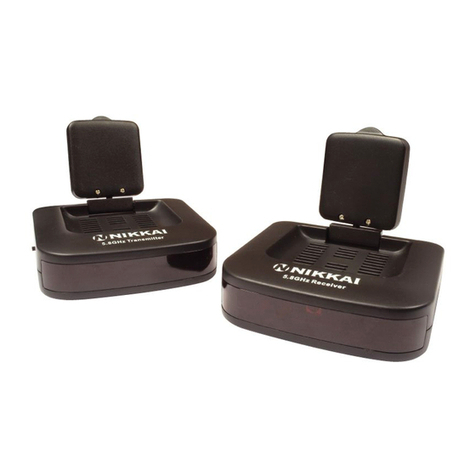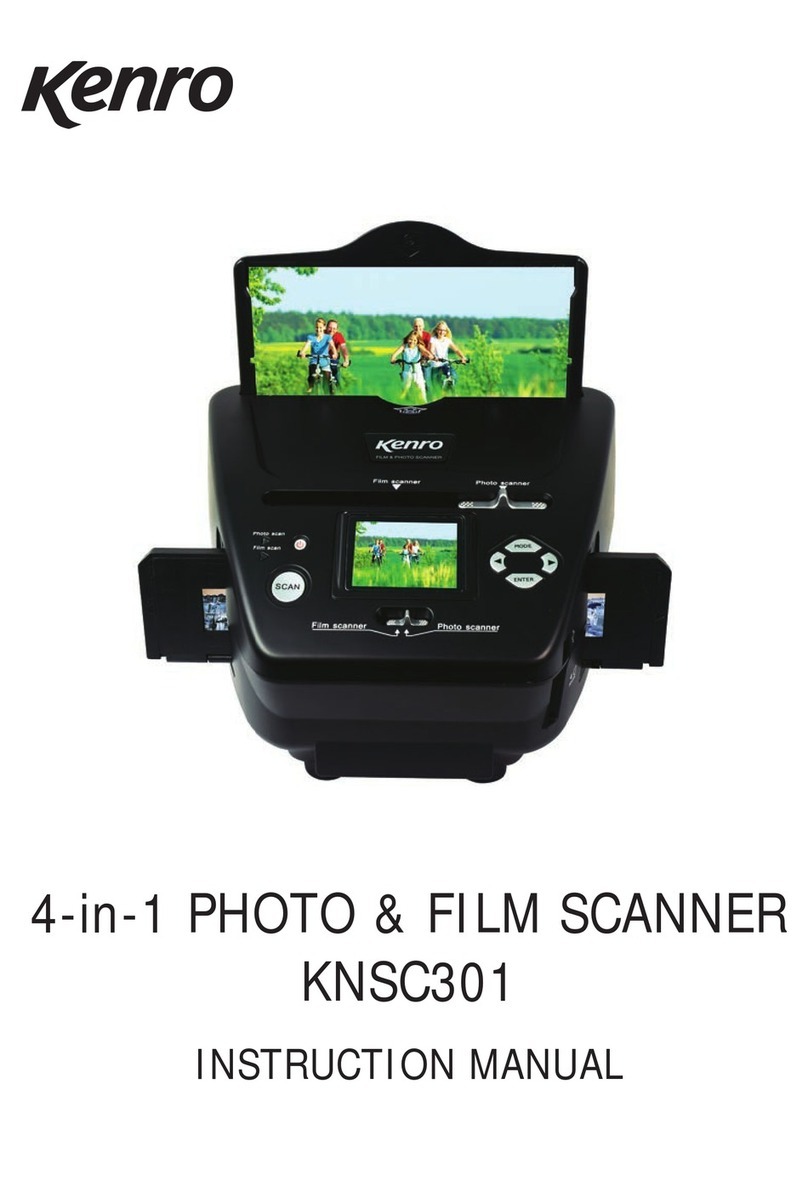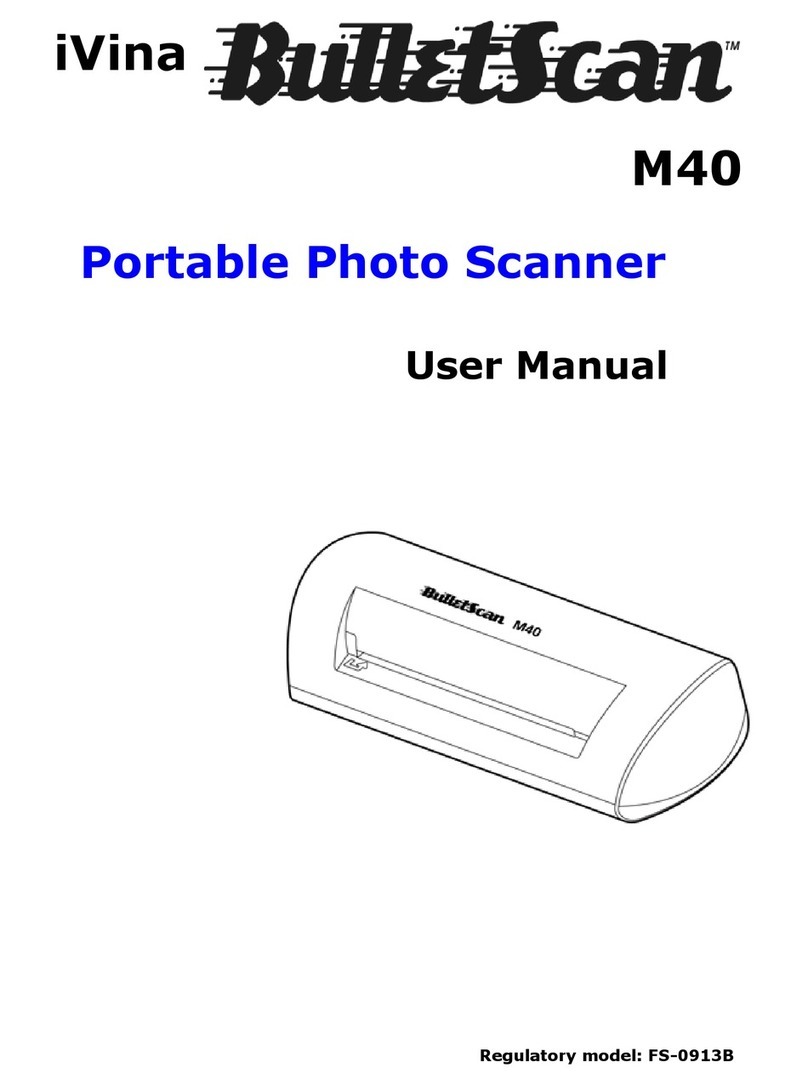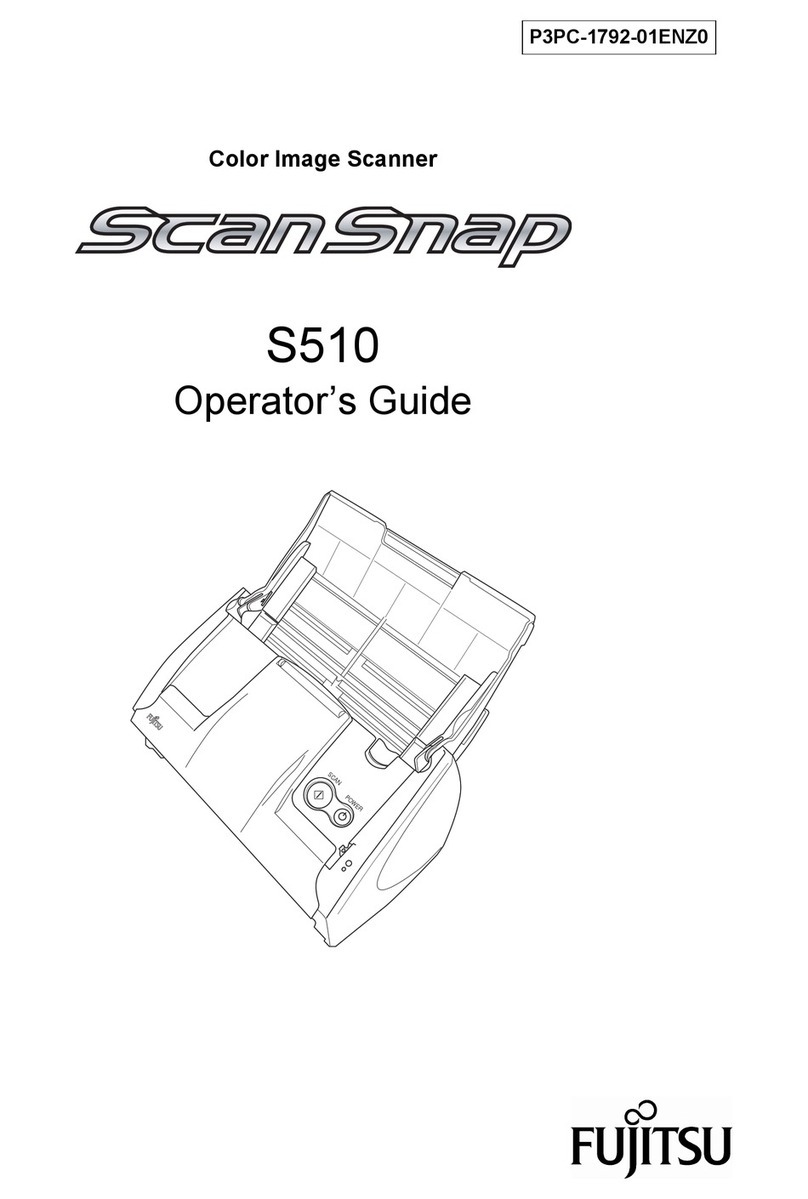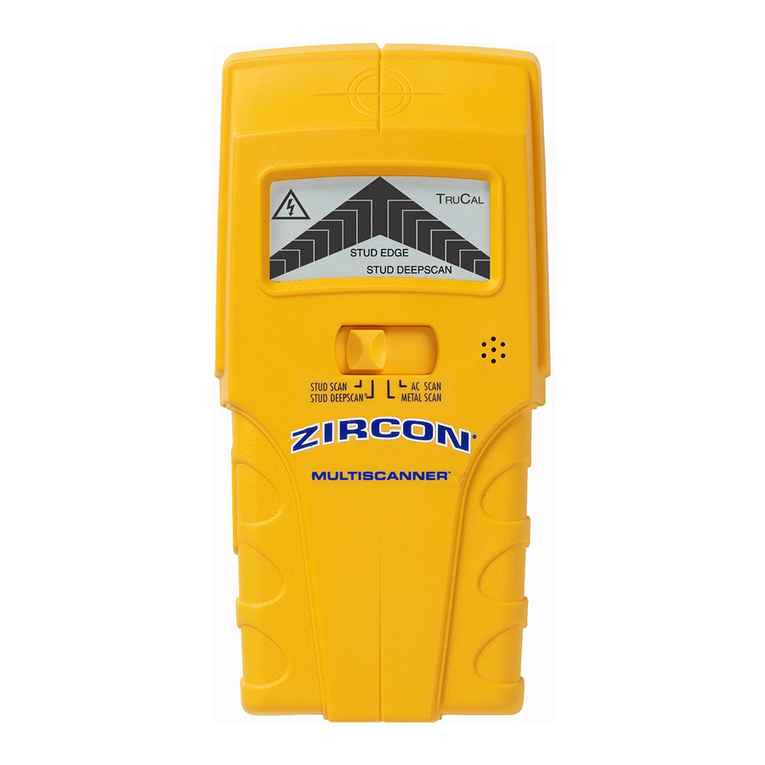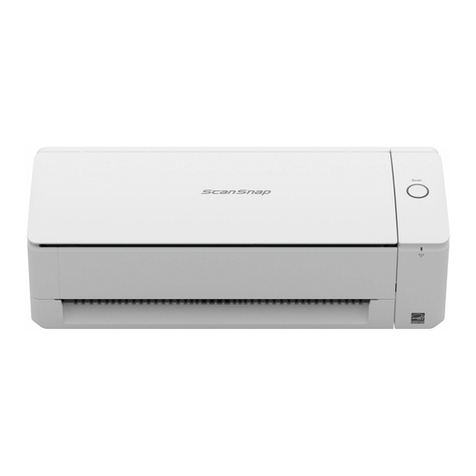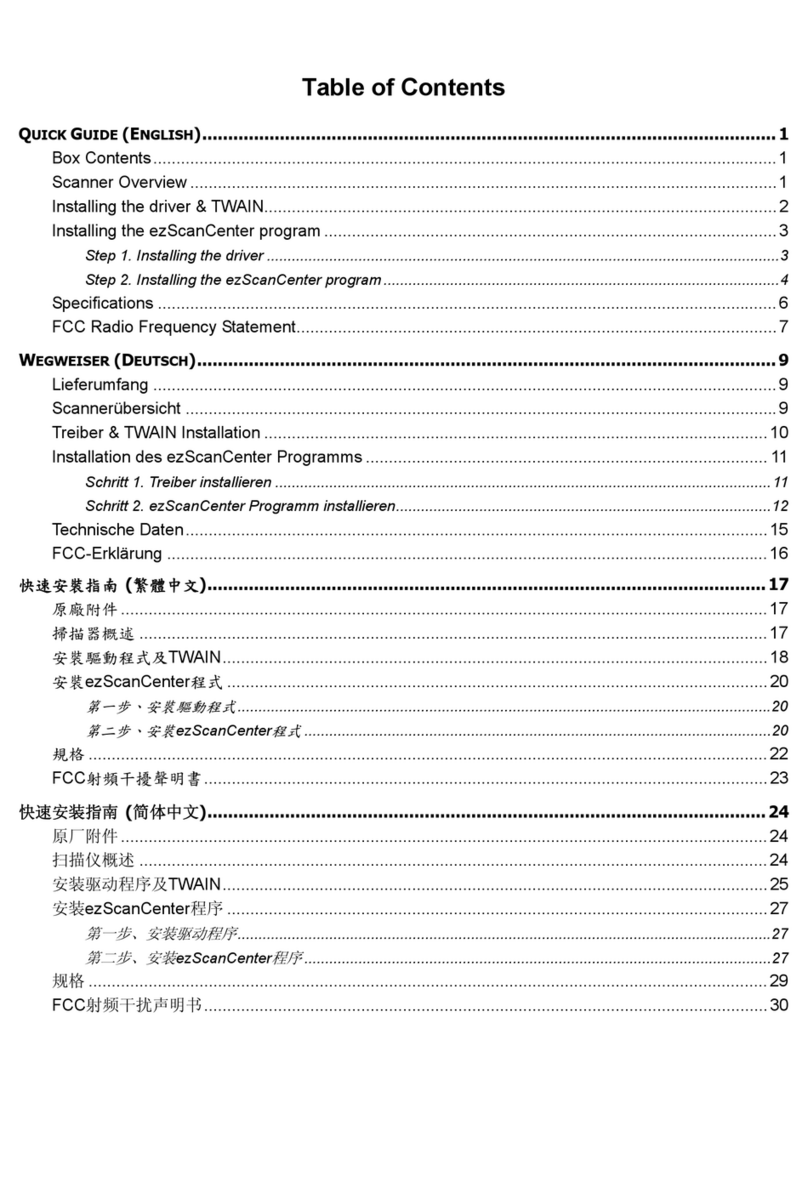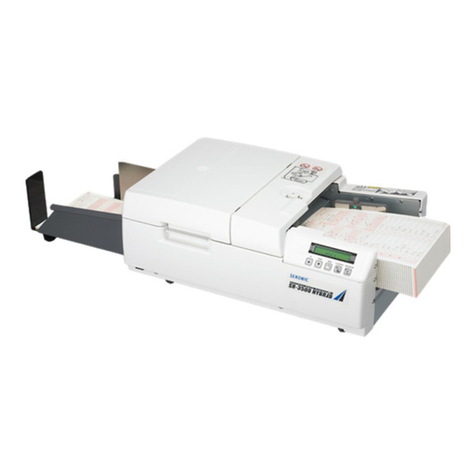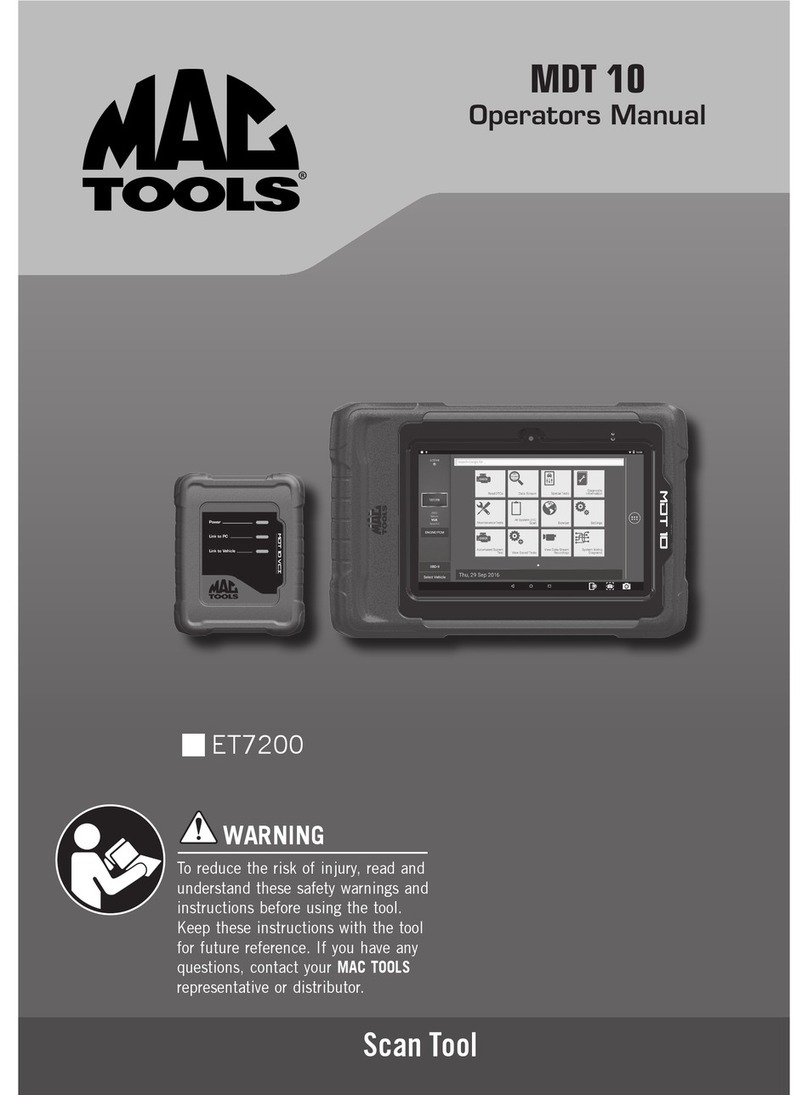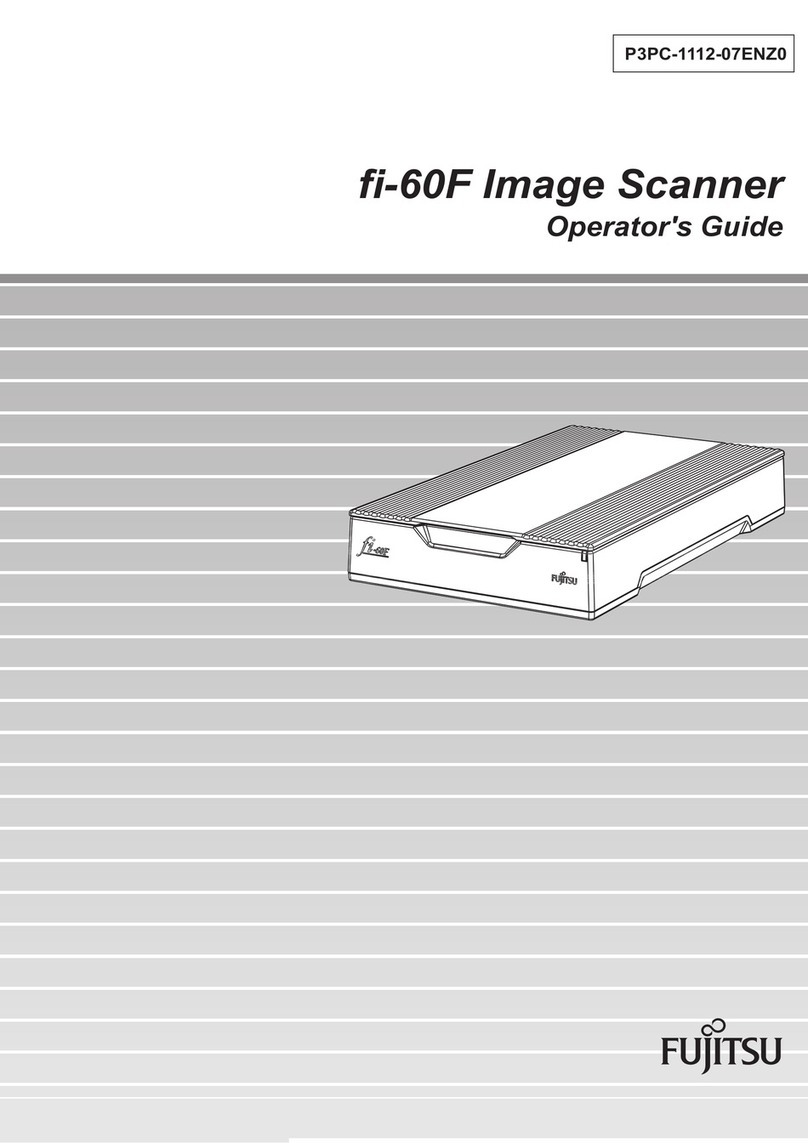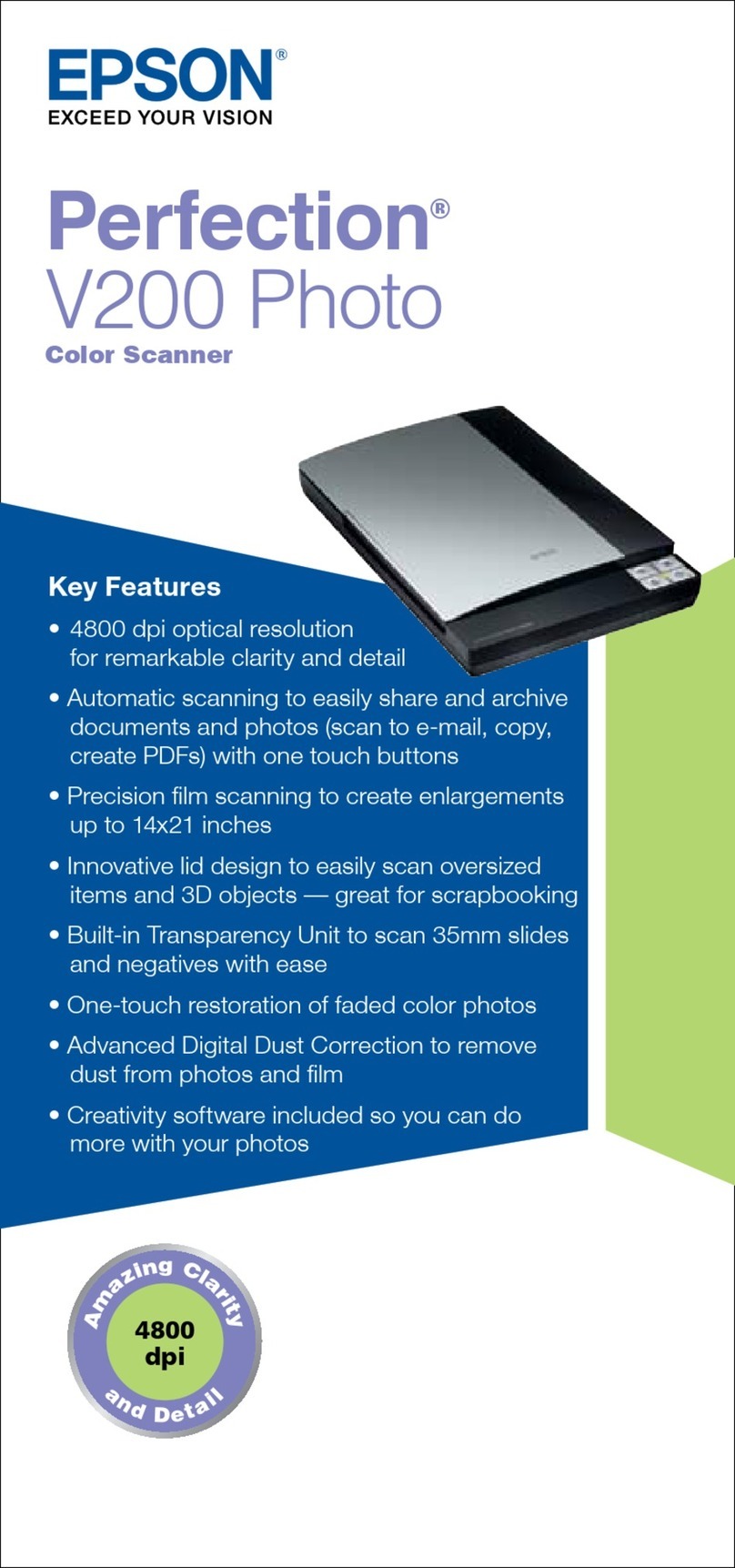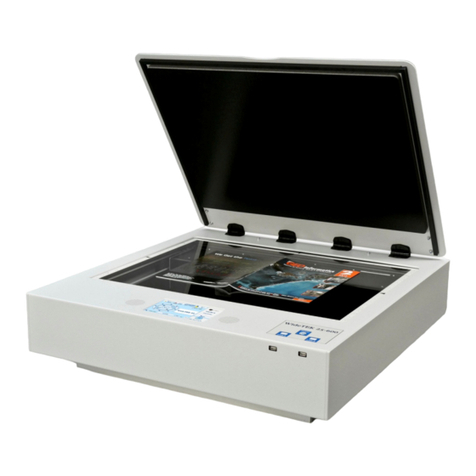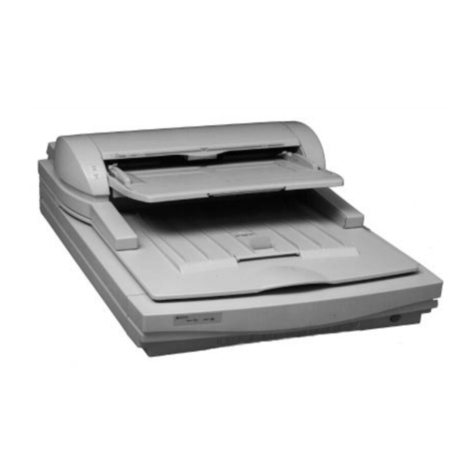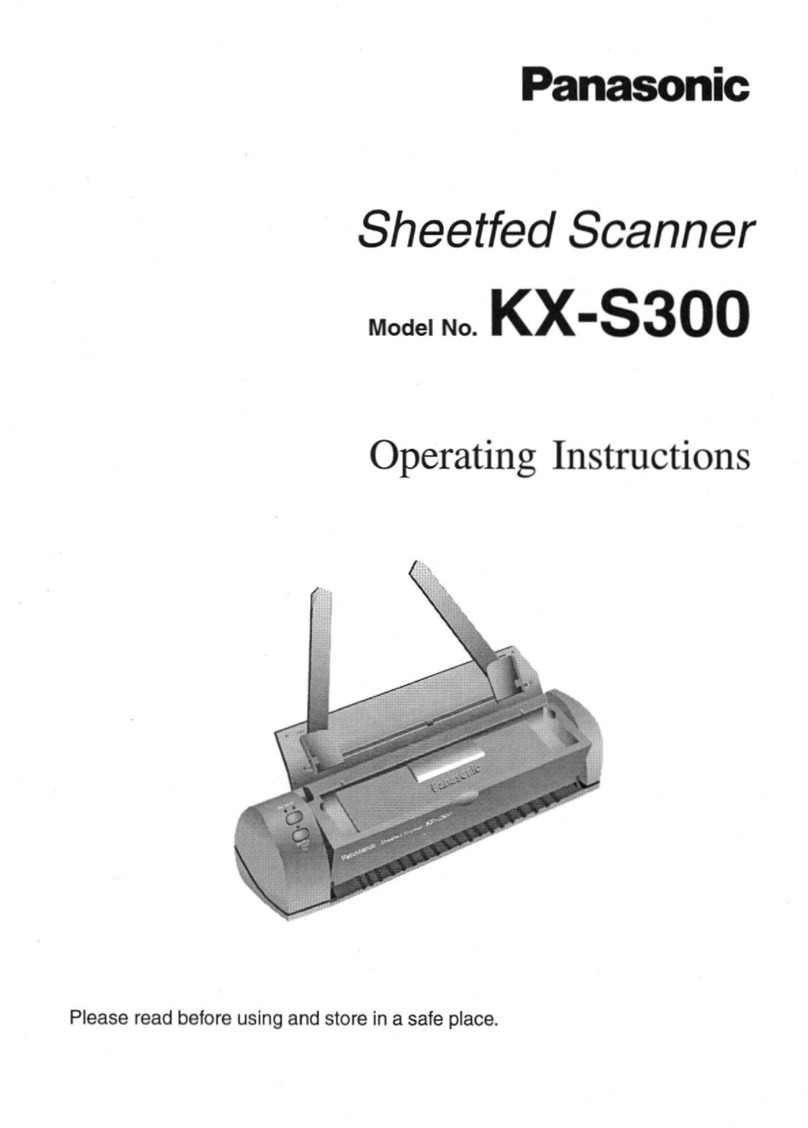Actron Super AutoScanner CP9145 User manual

6XSHU
$XWR6FDQQHU
&3
&3
8VHU
’
V0DQXDO

Copyright Information
Copyright © 2004 Actron Manufacturing, Inc.
All rights reserved.
The information, specifications and illustrations in
this manual are based on the latest information
available at the time of printing. Actron
Manufacturing reserves the right to make
changes at any time without notice.
Tool Information
Complete the following list using the
function “Tool Information” on
page 2-5. Provide this information when
contacting customer support.
Serial No:
SW ID:
HW Ver:
Boot Ver:
Prod ID:
Board ID:
Burn Date:
Burn Loc:

• • • • • • • • • • • • • • • • • • • • • • • • • • • • • • • • • • • • • • • • • • • • • • • • • • • • • • Safety – i
!
6DIHW\3UHFDXWLRQV
For your safety, read this manual thoroughly before operating your Super
AutoScanner™. The safety messages presented below and throughout this
user’smanualarereminderstotheoperatortoexerciseextremecarewhenusing
this test instrument.
Before using the scan tool, always refer to and follow safety messages and
applicable test procedures provided by the manufacturer of the vehicle or
equipment being tested.
Use equipment only as described in this manual.
Read All Instructions
Read, understand and follow all safety messagesand instructions in this manual
andonthetestequipment.Safetymessagesinthissectionofthemanualcontain
a signal word with a three-part message and, in some instances, an icon. The
signal word indicates the level of the hazard in a situation.
Safety Messages
Safety messages are provided to help prevent personal injury and equipment
damage. All safety messages are introduced by a signal word indicating the
hazard level. The types of safety messages are:
Indicates an imminently hazardous situation which, if not
avoided, will result in death or serious injury to the operator
or to bystanders.
Indicates a potentially hazardous situation which, if not
avoided, could result in death or serious injury to the
operator or to bystanders.
Indicates a potentially hazardous situation which, if not
avoided, may result in moderate or minor injury to the
operator or to bystanders.
Indicates a situation which, if not avoided, may result in
damage to the test equipment or vehicle.
Safety messages contain three different type styles.
• Normal type states the hazard.
•Bold type states how to avoid the hazard.
•Italic type states the possible consequences of not avoiding the hazard.
Example:Engine systems can malfunction expelling fuel, oil vapors, hot
steam, hot toxic exhaust gases, acid, refrigerant and other debris.
Wear safety goggles and protective gloves, user and
bystander. Everyday eyeglasses only have impact resistant
lenses, they are NOT safety glasses.
Engine systems that malfunction can cause injury.
!
DANGER
!
WARNING
!
CAUTION
IMPORTANT

Safety Precautions • • • • • • • • • • • • • • • • • • • • • • • • • • • • • • • • • • • • • • • • • • • • • • • • • • • • •
Safety – ii • • • • • • • • • • • • • • • • • • • • • • • • • • • • • • • • • • • • • • • • • • • • • • • • • • • • •
!
Important Safety Instructions
Somevehiclesareequippedwithairbags.Youmustfollowvehicle
service manual’s warnings when working around the air bag
components or wiring. If the service manual’s instructionsare not
followed, the air bag may open up unexpectedly, resulting in
personal injury. Note that the air bag can still open up several
minutes after the ignition key is off (or even if the vehicle battery
is disconnected) because of a special energy reserve module.
Risk of electric shock.
• Do not exceed voltage limits betweeninputs as indicatedin
the “Specifications” on page 2-2.
• Use extreme caution when working with circuits that have
greater than 60 volts DC or 24 volts AC.
Electric shock can cause injury.
Risk of explosion.
• Wear safety goggles and protective clothing, user and
bystander.Everydayeyeglassesonlyhaveimpactresistant
lenses, they are NOT safety glasses.
• Do not use this system in environments where explosive
vapor may collect, such as in below-ground pits, confined
areas, or areas that are less than 18 inches above the floor.
• Use this equipment in locations with mechanical
ventilation providing at least four air changes per hour.
• Flammable fuel and vapors can ignite.
• Do not smoke, strike a match, or cause a spark in the
vicinity of the battery. Battery gases can ignite.
• Avoid making accidental connection between battery
terminals. Do not place uninsulated metal tools on the
battery.
• When removing battery cables, remove ground cable first.
• Avoid sparks when connecting or disconnecting power
leads to battery.
• Be sure ignition is OFF, headlights and other accessories
are OFF andvehicledoors areclosed before disconnecting
batterycables.Thisalsohelpspreventdamagetoon-board
computer systems.
• Always disconnect battery ground connections before
servicing electrical system components.
Explosion can cause injury.
Risk of poisoning.
• Use this equipment in locations with mechanical
ventilation providing at least four air changes per hour.
Engine exhaust contains odorless lethal gas.
• Route exhaust outside while testing with engine running.
Poisoning can result in death or serious injury.
!
DANGER
!
WARNING

• • • • • • • • • • • • • • • • • • • • • • • • • • • • • • • • • • • • • • • • • • • • • • • • • • • • • Safety – iii
• • • • • • • • • • • • • • • • • • • • • • • • • • • • • • • • • • • • • • • • • • • • • • • • • • • • • Safety Precautions
!
Battery acid is a highly corrosive sulfuric acid.
• Wear safety goggles and protective gloves, user and
bystander.Everydayeyeglassesonlyhaveimpactresistant
lenses, they are NOT safety glasses.
• Make sure someone can hear you or is close enough to
provide aid when working near a battery.
• Have plenty of fresh water and soap nearby. If battery acid
contacts skin, clothing, or eyes, flush exposed area with
soap and water for 10 minutes.
• Seek medical help.
• Do not touch eyes while working near battery.
Battery acid can burn eyes and skin.
Risk of fire.
• Wear safety goggles and protective clothing, user and
bystander.Everydayeyeglassesonlyhaveimpactresistant
lenses, they are NOT safety glasses.
• Do not position head directly over or in front of throttle
body. Do not pour gasoline down throttle body when
cranking or running engine, when working with fuel
delivery systems or any open fuel line.Engine backfirecan
occur when air cleaner is out of position.
• Do notuse fuel injector cleaningsolvents when performing
diagnostic testing.
• Keep cigarettes, sparks, open flame and other sources of
ignition away from vehicle.
• Keep a dry chemical (Class B) fire extinguisher rated for
gasoline, chemical and electrical fires in work area.
Fire can cause death or serious injury.
Risk of flying particles.
Wear safety goggles while using electrical equipment.
Electrical equipment or rotating engine parts can cause
flying particles.
Flying particles can cause eye injury.
Risk of burns.
Batteriescan produce ashort-circuit current high enoughto
weld jewelry to metal. Remove jewelry such as rings,
bracelets and watches before working near batteries.
Short circuits can cause injury.
Risk of burns.
• Do not remove radiator cap unless engine is cold.
Pressurized engine coolant may be hot.
• Do not touch hot exhaust systems, manifolds, engines,
radiators, sample probe, etc.
• Wear insulated gloves when handling hot engine
components.
• Testerleadscan becomehot afterextendedtestingin close
proximity to manifolds etc.
Hot components can cause injury.
!
WARNING
!
WARNING

Safety Precautions • • • • • • • • • • • • • • • • • • • • • • • • • • • • • • • • • • • • • • • • • • • • • • • • • • • • •
Safety – iv • • • • • • • • • • • • • • • • • • • • • • • • • • • • • • • • • • • • • • • • • • • • • • • • • • • •
!
Risk of expelling fuel, oil vapors, hot steam, hot toxic exhaust
gases, acid, refrigerant and other debris.
• Wear safety goggles and protective clothing, user and
bystander.Everydayeyeglassesonlyhaveimpactresistant
lenses, they are NOT safety glasses.
• Engine systems can malfunction expelling fuel, oil vapors,
hot steam, hot toxic exhaust gases, acid, refrigerant and
other debris.
Fuel, oil vapors, hot steam, hot toxic exhaust gases, acid,
refrigerant and other debris can cause serious injury.
The engine compartment contains electrical connections and hot
or moving parts.
• Keep yourself, test leads, clothing and other objects clear
of electrical connections and hot or moving engine parts.
• Do not wear watches, rings, or loose fitting clothing when
working in an engine compartment.
• Do not place test equipment or tools on fenders or other
places in the engine compartment.
• Barriers are recommended tohelp identifydangerzones in
test area.
• Prevent personnel from walking through immediate test
area.
Contact with electrical connections and hot or moving parts can
cause injury.
Risk of injury.
• This equipment should be operated byqualified personnel
only.
• Use this equipment only as described in this manual. Use
only the manufacturer’s recommended attachments.
• Do not operate equipment with a damaged cord or if the
equipment hasbeen dropped or damaged, until it has been
examined by a qualified service representative.
Operation of this equipment by anyone other than qualified
personnel may result in injury.
Risk of unexpected vehicle movement.
• Block drive wheels before performing a test with engine
running.
• Unless instructed otherwise, set parking brake and put
gear selector in neutral for standard transmissions or park
for automatic transmissions.
• If vehicle has an automatic parking brake release,
disconnect release mechanism for testing and reconnect
when testing is completed.
• Do not leave a running engine unattended.
A moving vehicle can cause injury.
PRNDL2
!
WARNING

• • • • • • • • • • • • • • • • • • • • • • • • • • • • • • • • • • • • • • • • • • • • • • • • • • • • • Safety – v
• • • • • • • • • • • • • • • • • • • • • • • • • • • • • • • • • • • • • • • • • • • • • • • • • • • • • Safety Precautions
!
Risk of equipment or circuit damage.
• Unless specifically directed by the manufacturer, make
sure the ignition is OFF before connecting or
disconnecting connectors or any vehicle electrical
terminals.
• Do not create a short between battery terminals with a
jumper wire or tools.
Improper equipment use can cause equipment or circuit
damage.
Misdiagnosis may lead to incorrect or improper repair and/or
adjustment.
Do not rely on erratic, questionable, or obviously erroneous
test information or results. If test information or results are
erratic, questionable, or obviously erroneous, make sure
that all connections and data entry information are correct
and that the test procedure was performed correctly. If test
information or results are still suspicious, do not use them
for diagnosis.
Improper repair and/or adjustment may cause vehicle or
equipment damage or unsafe operation.
!
CAUTION
!
CAUTION

Safety Precautions • • • • • • • • • • • • • • • • • • • • • • • • • • • • • • • • • • • • • • • • • • • • • • • • • • • • •
Safety – vi • • • • • • • • • • • • • • • • • • • • • • • • • • • • • • • • • • • • • • • • • • • • • • • • • • • •
!

ToC
Table of Contents
Safety Precautions
Part 1 – Getting Started
Manual Conventions . . . . . . . . . . . . . . . . . . . . . . . . . . . . . . . . . . . . . . . . . . 1-1
On-Board Diagnostics . . . . . . . . . . . . . . . . . . . . . . . . . . . . . . . . . . . . . . . . 1-2
Diagnostic Link Connectors (DLC) . . . . . . . . . . . . . . . . . . . . . . . . . . . . . . 1-4
OBD II (J1962) DLC . . . . . . . . . . . . . . . . . . . . . . . . . . . . . . . . . . . . . . . . 1-4
Ford Historic (OBD I) . . . . . . . . . . . . . . . . . . . . . . . . . . . . . . . . . . . . . . . 1-5
GM Historic (OBD I) . . . . . . . . . . . . . . . . . . . . . . . . . . . . . . . . . . . . . . . . 1-6
Chrysler . . . . . . . . . . . . . . . . . . . . . . . . . . . . . . . . . . . . . . . . . . . . . . . . . 1-7
Diagnostic Trouble Codes (DTCs) . . . . . . . . . . . . . . . . . . . . . . . . . . . . . . . 1-8
Vehicle Service Information . . . . . . . . . . . . . . . . . . . . . . . . . . . . . . . . . . . . 1-9
Part 2 – Using The Tool
Tool Description . . . . . . . . . . . . . . . . . . . . . . . . . . . . . . . . . . . . . . . . . . . . . 2-1
Specifications . . . . . . . . . . . . . . . . . . . . . . . . . . . . . . . . . . . . . . . . . . . . . 2-2
Accessories . . . . . . . . . . . . . . . . . . . . . . . . . . . . . . . . . . . . . . . . . . . . . . 2-2
Display . . . . . . . . . . . . . . . . . . . . . . . . . . . . . . . . . . . . . . . . . . . . . . . . . . 2-2
Keyboard . . . . . . . . . . . . . . . . . . . . . . . . . . . . . . . . . . . . . . . . . . . . . . . . 2-3
Power . . . . . . . . . . . . . . . . . . . . . . . . . . . . . . . . . . . . . . . . . . . . . . . . . . . 2-3
Scan Tool Operation . . . . . . . . . . . . . . . . . . . . . . . . . . . . . . . . . . . . . . . . . . 2-4
Tool Power-Up . . . . . . . . . . . . . . . . . . . . . . . . . . . . . . . . . . . . . . . . . . . . 2-4
Tool Navigation . . . . . . . . . . . . . . . . . . . . . . . . . . . . . . . . . . . . . . . . . . . . 2-4
Tool Setup . . . . . . . . . . . . . . . . . . . . . . . . . . . . . . . . . . . . . . . . . . . . . . . 2-4
Vehicle Selection . . . . . . . . . . . . . . . . . . . . . . . . . . . . . . . . . . . . . . . . . . 2-5
Part 3 – Global OBD II Diagnostics
I/M Readiness . . . . . . . . . . . . . . . . . . . . . . . . . . . . . . . . . . . . . . . . . . . . . . . 3-1
Read Codes . . . . . . . . . . . . . . . . . . . . . . . . . . . . . . . . . . . . . . . . . . . . . . . . . 3-4
Erase Codes . . . . . . . . . . . . . . . . . . . . . . . . . . . . . . . . . . . . . . . . . . . . . . . . 3-5
View Data . . . . . . . . . . . . . . . . . . . . . . . . . . . . . . . . . . . . . . . . . . . . . . . . . . . 3-6
View Freeze Data . . . . . . . . . . . . . . . . . . . . . . . . . . . . . . . . . . . . . . . . . . . . . 3-7
Review Data . . . . . . . . . . . . . . . . . . . . . . . . . . . . . . . . . . . . . . . . . . . . . . . . . 3-8
Part 4 – GM Historic Diagnostics
Read Codes . . . . . . . . . . . . . . . . . . . . . . . . . . . . . . . . . . . . . . . . . . . . . . . . . 4-1
Erase Codes . . . . . . . . . . . . . . . . . . . . . . . . . . . . . . . . . . . . . . . . . . . . . . . . 4-2
View Data . . . . . . . . . . . . . . . . . . . . . . . . . . . . . . . . . . . . . . . . . . . . . . . . . . . 4-3
Review Data . . . . . . . . . . . . . . . . . . . . . . . . . . . . . . . . . . . . . . . . . . . . . . . . . 4-4
Field Service . . . . . . . . . . . . . . . . . . . . . . . . . . . . . . . . . . . . . . . . . . . . . . . . 4-4

ToC
Part 5 – Ford Historic Diagnostics
Read KOEO Codes . . . . . . . . . . . . . . . . . . . . . . . . . . . . . . . . . . . . . . . . . . . 5-1
Read KOER Codes . . . . . . . . . . . . . . . . . . . . . . . . . . . . . . . . . . . . . . . . . . . 5-2
Fast or Slow Codes . . . . . . . . . . . . . . . . . . . . . . . . . . . . . . . . . . . . . . . .. 5-4
Computed Timing Check (1984-1991 EEC-IV Vehicles) . . . . . . . . . . .. 5-5
Review Codes . . . . . . . . . . . . . . . . . . . . . . . . . . . . . . . . . . . . . . . . . . . . . . . 5-6
Erase Codes . . . . . . . . . . . . . . . . . . . . . . . . . . . . . . . . . . . . . . . . . . . . . . . . . 5-7
EEC-IV Erase Codes . . . . . . . . . . . . . . . . . . . . . . . . . . . . . . . . . . . . . .. 5-7
MECS Erase Codes . . . . . . . . . . . . . . . . . . . . . . . . . . . . . . . . . . . . . . .. 5-7
Wiggle Test (EEC-IV Vehicles) . . . . . . . . . . . . . . . . . . . . . . . . . . . . . . . . . . 5-8
Output Switch Test (EEC-IV Vehicles) . . . . . . . . . . . . . . . . . . . . . . . . . . . . 5-9
DCL Data Functions (EEC-IV Vehicles) . . . . . . . . . . . . . . . . . . . . . . . . . 5-10
Cyl Balance Test (EEC-IV Vehicles) . . . . . . . . . . . . . . . . . . . . . . . . . . . . . 5-11
IVSC-Speed Ctrl (EEC-IV Vehicles) . . . . . . . . . . . . . . . . . . . . . . . . . . . . . 5-13
STAR Test Mode . . . . . . . . . . . . . . . . . . . . . . . . . . . . . . . . . . . . . . . . . . . . 5-15
Part 6 – Chrysler Historic Diagnostics
Read Codes . . . . . . . . . . . . . . . . . . . . . . . . . . . . . . . . . . . . . . . . . . . . . . . . . 6-1
Erase Codes . . . . . . . . . . . . . . . . . . . . . . . . . . . . . . . . . . . . . . . . . . . . . . . . . 6-3
View Data . . . . . . . . . . . . . . . . . . . . . . . . . . . . . . . . . . . . . . . . . . . . . . . . . . . 6-4
Switch Test . . . . . . . . . . . . . . . . . . . . . . . . . . . . . . . . . . . . . . . . . . . . . . . . . . 6-5
Actuator Test . . . . . . . . . . . . . . . . . . . . . . . . . . . . . . . . . . . . . . . . . . . . . . . . 6-6
Idle Speed Test . . . . . . . . . . . . . . . . . . . . . . . . . . . . . . . . . . . . . . . . . . . . . . 6-7
Sensor Test . . . . . . . . . . . . . . . . . . . . . . . . . . . . . . . . . . . . . . . . . . . . . . . . . 6-7
Review Data . . . . . . . . . . . . . . . . . . . . . . . . . . . . . . . . . . . . . . . . . . . . . . . . . 6-8
Part 7 – Help & Troubleshooting
How to Use On-Line Help . . . . . . . . . . . . . . . . . . . . . . . . . . . . . . . . . . . . . . 7-1
Tool Does Not Power Up . . . . . . . . . . . . . . . . . . . . . . . . . . . . . . . . . . . . . . . 7-1
Using Non-OBD II Adapter Cables . . . . . . . . . . . . . . . . . . . . . . . . . . . .. 7-2
Using J1962 (OBD II) or Chrysler LH Adapter Cable . . . . . . . . . . . . . .. 7-2
Error Messages . . . . . . . . . . . . . . . . . . . . . . . . . . . . . . . . . . . . . . . . . . . . . . 7-3
Vehicle Communication Fault . . . . . . . . . . . . . . . . . . . . . . . . . . . . . . . .. 7-3
Operating Error or Erroneous Data . . . . . . . . . . . . . . . . . . . . . . . . . . . .. 7-3
Battery Replacement . . . . . . . . . . . . . . . . . . . . . . . . . . . . . . . . . . . . . . . . . . 7-4
Tool Self-Tests . . . . . . . . . . . . . . . . . . . . . . . . . . . . . . . . . . . . . . . . . . . . . . . 7-4
Display Test . . . . . . . . . . . . . . . . . . . . . . . . . . . . . . . . . . . . . . . . . . . . .. 7-5
Keyboard Test . . . . . . . . . . . . . . . . . . . . . . . . . . . . . . . . . . . . . . . . . . . .. 7-5
Memory Test . . . . . . . . . . . . . . . . . . . . . . . . . . . . . . . . . . . . . . . . . . . . .. 7-6
Program Mode . . . . . . . . . . . . . . . . . . . . . . . . . . . . . . . . . . . . . . . . . . .. 7-6
Technical Support . . . . . . . . . . . . . . . . . . . . . . . . . . . . . . . . . . . . . . . . . . . . 7-6
Appendix A – Data Link Connectors
Appendix B – Glossary

1
• • • • • • • • • • • • • • • • • • • • • • • • • • • • • • • • • • • • • • • • • • • • • • • • • • • • • • • • • 1 – 1
3DUW *HWWLQJ6WDUWHG
The SUPER AutoScanner™ was developed by expertsin the automotive service
industry to help diagnose vehicles and assist in troubleshooting procedures. The
tool will monitor vehicle events and to read codes from the computer’s memory
to pinpoint problem areas.
Allinformation,illustrationsandspecificationscontainedinthismanualarebased
onthelatestinformationavailablefromindustrysourcesatthetimeofpublication.
No warranty (expressed or implied) can be made for its accuracy or
completeness, nor is any responsibility assumed by the manufacturer or anyone
connectedwithitforlossordamagessufferedthroughrelianceonanyinformation
contained in this manual or misuse of accompanying product. The manufacturer
reserves the right to make changes at any time to this manual or accompanying
product without obligation to notify any person or organization of such changes.
MANUAL CONVENTIONS
This manual provides instructions to setup and use your SUPER
AUTOSCANNER™. A glossary and application charts provide valuable
reference material. Some of the information shown in text or illustrations is
obtained using optional equipment. A Sales Representative can help determine
option availability. This section contains a list of conventions used.
Safety Messages
Refer to “Safety Precautions” at the beginning of this manual.
Check Note
A check note provides additional information about the subject in the preceding
paragraph.
Example:
✓Make sure the printer is turned on, on-line and connected.
Tips and Lists
Tips and lists provideinformation that applies to specific systems and processes.
Each tip is introduced by this icon ❒for easy identification.
Example:
❒Use the
83'2:1
arrow keys to move up/down through the display or
move the cursor ([) to a selectable item.
Equipment Damage
Situations arise during testing that could damage the vehicle or the test
equipment. The word IMPORTANT signals these situations.
Example:
Screens may differ slightly for vehicle make and year.
Functions and Selections
Diagnostic and tool functions performed by the tool are highlighted in bold.
Example:
Select Read Codes and press
(17(5
.

Getting Started • • • • • • • • • • • • • • • • • • • • • • • • • • • • • • • • • • • • • • • • • • • • • • • • • • • • • • • •
1 – 2• • • • • • • • • • • • • • • • • • • • • • • • • • • • • • • • • • • • • • • • • • • • • • • • • • • • • • • • •
1
Menus
The menus on the tool display are referenced in the procedures and are
highlighted in bold-italic text.
Example:
Press the
(17(5
key to return to theGM Function List.
Questions and Responses
Messages and user responses are CAPITALIZED.
Example:
Selecting NO displays a COMMAND CANCELLED message prompting you to
press
(17(5
to continue back to the OBDII Function List.
Manual References
Used to reference other sections of the manual. References include the “Title”
and page number (section-page).
Example:
Complete the following list using the function “Tool Information” on page 2-5.
Screens
The screens are presented as examples and may change as the software is
updated.
Example:
ON-BOARD DIAGNOSTICS
The original on-board diagnostics (OBD I) lacked consistency in communication
and interface while allowing different interpretations amongst vehicle
manufacturers. Ford used several types of engine control computers, Chrysler
used several types of data link connectors and GM varied the trouble codes and
communication protocols from year-to-year.
The following tables highlight changes for GM, Ford, and Chrysler. If this seems
confusing; don’t worry. Your tool makes it easy. Based on the VIN information
selected during Scan Tool setup, the processor is automatically recognized. All
you have to do is choose the correct adapter cable and jumper wires (if
necessary). Details on adapter cables and jumper wires may be found in
“Diagnostic Link Connectors (DLC)” on page 1-4.
GM On-Board Diagnostics
System Years Description
OBD I Control Module
1981–1995
Most vehicles used the 12-pin ALDL (Assembly Line Data Link)
located under the dash on the driver side. Some 94-95 vehicles
used the 16-pin OBD II (J1962) data link connector (DLC), but
use the Historical application software. Refer to the vehicle’s
Vehicle Emission Control Information label.
OBD II Control Module
1994*-Present Complies with OBD II regulations and uses the J1962 DLC.
*
OBD II system used in certain 1994-1995 vehicles equipped with a 2.2L, 2.3L, 3.8L, 4.3L or 5.7L engines.
!3;@!7@G ^
[ *7:;5>7;39@AE;E
(AA>'7FGB ]
(AA>'7>8W(7EFE

• • • • • • • • • • • • • • • • • • • • • • • • • • • • • • • • • • • • • • • • • • • • • • • • • • • • • • • • • 1 – 3
• • • • • • • • • • • • • • • • • • • • • • • • • • • • • • • • • • • • • • • • • • • • • • • • • • • • • • • • Getting Started
1
OBD II stands for On-Board Diagnostics version II. OBD II is a system that the
Society of Automotive Engineers (SAE) developed to standardize automotive
electronic diagnosis. Technicians now can use the same tool to test any OBD II
compliantvehicleswithoutspecialadapters.TheestablishedSAEguidelinesare:
• a universal diagnostic test connector, called the data link connector (DLC),
with dedicated pin assignments.
• a standardized location for the DLC, visible under the dash on the driver’s
side.
• a standardized list of diagnostic trouble codes (DTCs) used by all
manufacturers.
• a standardized list of parameter identification (PID) data used by all
manufacturers.
• the ability of the vehicle system to record a freeze frame of the operating
conditions when a fault occurs.
• expanded diagnostic capabilities that records a code whenever a condition
occurs that effects vehicle emissions.
• the ability to clear stored codes from vehicle memory with the scan tool.
In addition, SAE has published hundreds of pages of text defining a standard
communications protocol that establishes the hardware, software, and circuit
parameters of OBD II systems. Unfortunately, vehicle manufacturers have
different interpretations of this standard communications protocol. As a result, the
genericOBDIIcommunicationsschemeusedwillvary,dependingonthevehicle.
Ford On-Board Diagnostics
System Long Name Years Description
MCU
Microprocessor Control Unit 1980 –1991 Used in police vehicles, containing carbureted
engines. Uses the MCU DLC.
EEC-IV
Electronic Engine Control,
Fourth generation 1984 –1995 Most Ford vehicles equipped with North American
engines. Uses the EEC-IV DLC.
MECS
Mazda Electronic Control
System 1988 –1995 Vehicles equipped with Mazda-sourced engines.
Uses MECS 6-pin and 17-pin DLCs.
EEC-V
Electronic Engine Control,
Fifth generation 1994* – present Complies with OBD II regulations and uses the
OBD II J1962 DLC.
PTEC
Powertrain Electronic Con-
troller 2000 – present Complies with OBD II regulations and uses the
OBD II J1962 DLC.
* EEC-V OBD II system used in 1994-1995 vehicles equipped with a 3.8L or 4.6L engine.
Chrysler On-Board Diagnostics
System Long Name Years Description
SMEC
Single Module
Engine Controller 1989–1990 Used a 6-pin Serial Communication Interface (SCI) DLC
and has bidirectional capability.
SBEC
Single Board Engine
Controller 1989*–1995 Used two types of DLCs: a 6-pin SCI and a 6-pin LH series.
The first to allow a tool to reset the EMR light on trucks.
OBD II
PCM
OBD II Powertrain
Control Module 1995**– present Complies with OBD II regulations and uses the OBD II
J1962 DLC.
JTEC
Jeep/Truck Engine
Controller 1996– present Complies with OBD II regulations and uses the OBD II
J1962 DLC.
The JTEC system is used on light-duty trucks and Jeeps
* In 1989, the SBEC system was installed in selected vehicles with 3.0L V6 engines.
** Some vehicles in 1995 were equipped with the OBD II PCM.

Getting Started • • • • • • • • • • • • • • • • • • • • • • • • • • • • • • • • • • • • • • • • • • • • • • • • • • • • • • • •
1 – 4• • • • • • • • • • • • • • • • • • • • • • • • • • • • • • • • • • • • • • • • • • • • • • • • • • • • • • • • •
1
SAE publishes recommendations, not laws, but the Environmental Protection
Agency (EPA) and California Air Resources Board (CARB) made manyof SAE’s
recommendations legal requirements that vehicle manufacturers were required
to phase in over a three-year period. Beginning in 1994, vehicles with a new
engine management computer – about 10% of each manufacturers fleet – were
supposed to comply with OBD II standards. For 1995, OBD II systems were to
appearonabout40%ofthenewvehiclessoldintheUSA.Someofthe1994-1995
OBD II systems were not fully compliant, so the Government granted waivers to
givemanufacturerstimetofine-tunetheirsystems.Beginningin1996,mostofthe
new vehicles sold in the USA were fully OBD II compliant.
DIAGNOSTIC LINK CONNECTORS (DLC)
The Data Link Connector (DLC) allows the scan tool to communicate with the
vehicle’s computer(s). Before OBD II, manufacturers used different data link
connectorsto communicate withthe vehicle.The proper DLC adapter cable must
be used to connect the tool to the vehicle. Also, the vehicle’s DLC may be found
in several different places and have many different configurations. The following
describes the DLCs used by Ford, GM and Chrysler. The DLC location and types
for domestic vehicles can be looked up in the charts in “Appendix A – Data Link
Connectors” .
OBD II (J1962) DLC
Beginningin1996,vehiclessoldinthe
United States use the J1962 DLC, a
term taken from a physical and
electrical specification number
assigned by SAE (J1962). OBD II
defines the physical and electrical
specification for the DLC. The DLC
shouldbelocatedunderthedashboardonthedriversideofthevehicle.IftheDLC
is not located under the dashboard as stated, a decal describing its location
should be attached to the dashboard in the area the DLC should have been
located.
Because the OBD II J1962 connector has power and ground, you only need a
single cable connection to the tool for both power and tool communications.
AttachtheOBDIIadaptercabletotheextendercable,bothsuppliedwiththetool,
to connect the tool. Certain pins in the connector are reserved.
1 - Manufacturer Reserved
2 - J1850 Bus+
3 - Manufacturer Reserved
4 - Chassis Ground
5 - Signal Ground
6 - CAN High, J-2284
7 - K Line, ISO 9141-2 & ISO/DIS 14230-4
8 - Manufacturer Reserved
9 - Manufacturer Reserved
10 - J1850 Bus
11 - Manufacturer Reserved
12 - Manufacturer Reserved
13 - Manufacturer Reserved
14 - CAN Low, J-2284
15 - L Line, ISO 9141-2 & ISO/DIS 14230-4
16 - Battery Power
1
9
8
16

• • • • • • • • • • • • • • • • • • • • • • • • • • • • • • • • • • • • • • • • • • • • • • • • • • • • • • • • • 1 – 5
• • • • • • • • • • • • • • • • • • • • • • • • • • • • • • • • • • • • • • • • • • • • • • • • • • • • • • • • Getting Started
1
Ford Historic (OBD I)
Since 1984, Ford used several different types of powertrain control modules
(PCM). Refer to “On-Board Diagnostics” on page 1-2. With the proper adapter
cables, your tool will be able to read these systems as well.
Use the Battery Power cable to provide 12V to the tool for all
systems.
EEC-IV System
The EEC-IV computer system
uses a large six-sided
connector and a pigtail
connector.
MCU System
The MCU computer system
uses the same six-sided
connector,but NOT thepigtail
connector. Leave the pigtail
unattached.
MECS (Mazda Electronic Control System)
MECS vehicles (1988 –1995) use either a 6-pin (with pigtail) or a 17-pin DLC. The
6-pin MECS adapter cable and jumper wires (P/N 9131) are used to connect the
tool to both DLCs. Both adapter cables are also available through your dealer.
6-Pin MECS.
IMPORTANT
Vehicle DLC
EEC-IV/MCU
Cable Adapter
EEC-IV/MCU
STI Pigtai
l
EEC-IV onl
y
To Scan
Tool
P/N CP9128
STI Pigtail
456
123
To Scan
Too l
6-Pin MECS
Clip to good
Vehicle ground
Cable Adapter
Vehicle DLC
6-Pin MECS
Pigtail
P/N CP9131

Getting Started • • • • • • • • • • • • • • • • • • • • • • • • • • • • • • • • • • • • • • • • • • • • • • • • • • • • • • • •
1 – 6• • • • • • • • • • • • • • • • • • • • • • • • • • • • • • • • • • • • • • • • • • • • • • • • • • • • • • • • •
1
17-Pin MECS
Use the 6-Pin
MECS and the
jumper wires.
MECS Ford Probe
Certain Probes have a WHITE TACH CONNECTOR located very
close to the 6-pin Self-Test connector and bundled in the same
wiring harness. This is NOT the STI (Self Test Input) Pigtail.
Connect the pigtail to
the BLACK STI
connector located
fartherbackonthewire
harness. If the tool is
connected to the
WHITE Tach
connector, serious
damage will result and
may void warranty.
Refer to the illustration.
GM Historic (OBD I)
Prior to1996, most GM vehicles used the standard 12-pin Assembly Line
DiagnosticLink(ALDL). Use theGM ALDL cable kit (p/nCP9127) which includes
the ALDL adapter and cigarette lighter power cable for these vehicles. In 1994 &
1995, certain GM vehicles used the J1962 DLC.
Use the Battery Power cable to provide 12V to the tool.
STI Pigtail
6-Pin MECS
STO
456
123
Clip to good
vehicle ground
Adapter Cable Vehicle DLC
17-Pin MECS
To
Scan Tool
P/N CP9128
IMPORTANT
STI
Pigtail
BLACK STI
Connector
WHITE
Tach
Connector
DO NOT USE!
6-Pin MECS
6-Pin MECS
456
123
To
Scan
Tool
Clip to good
vehicle ground
Cable Adapter
6-Pin MECS
Vehicle DLC
6-Pin MECS
Windshield
Wiper
Motor
P/N CP9128
IMPORTANT

• • • • • • • • • • • • • • • • • • • • • • • • • • • • • • • • • • • • • • • • • • • • • • • • • • • • • • • • • 1 – 7
• • • • • • • • • • • • • • • • • • • • • • • • • • • • • • • • • • • • • • • • • • • • • • • • • • • • • • • • Getting Started
1
ALDL
The ALDL DLCs are usually located under
the dashboard on the driver’s side.
Corvettes & Fieros:
Sometimes, the DLC is located in the center console behind the ashtray. Refer to
vehicle service manual for exact location. It may be in full view, or it may be
recessed behind a panel. An opening in the panel should allow access to the
recessed connector.
Chrysler Use the Battery Power cable to provide 12V to the tool for both
systems.
SCI
The SCI (serial communicationsinterface)DLC is a 6-pin
connector located in the engine compartment. The
adaptercabletobeusedonthesevehiclesissuppliedwith
thetool.ThiscableislabeledCHRY onthe15pinDBstyle
connector and SCI on the vehicle end.
LH-series
The LH-series data link connector is used on LH platform
vehicles. The LH style DLC is a small, blue, rectangular
6-pin connector located in the passenger compartment
below the dashboard to the right of the steering column.
TheLHAdapterCable(P/N CP9130)is optionaland must
be purchased separately.
F
G
E
H
D
J
C
K
B
L
A
M
ALDL (P/N CP9127)
IMPORTANT
SCI (P/N CP9129)
LH (P/N CP9130)

Getting Started • • • • • • • • • • • • • • • • • • • • • • • • • • • • • • • • • • • • • • • • • • • • • • • • • • • • • • • •
1 – 8• • • • • • • • • • • • • • • • • • • • • • • • • • • • • • • • • • • • • • • • • • • • • • • • • • • • • • • • •
1
DIAGNOSTIC TROUBLE CODES (DTCS)
Diagnostic Trouble Codes (DTCs) consist of a five-digit alphanumeric code. The
DTC format and general code types are shown below. When the on-board
computer recognizes and identifies a problem, a DTC for that fault is stored in
memory. These codes are intended to help you determine the root cause of a
problem
.
J2012 and ISO 15031-6 are standards for all DTCs, established by the SAE,
International Organization for Standardization (ISO) and other governing bodies.
Codes and the definitions assigned by this specification are known as Generic
OBD II codes. OBD II requires compliance of this standard, and has made it a
standard for all cars, light trucks, APVs, MPVs, and SUVs sold in the U.S.Codes
not reserved by the SAE are reserved for the manufacturer and referred to as
Manufacturer Specific.
Example:
P0101 - Mass or Volume Air Flow Circuit Range/Performance Problem
P0 1 0 1
Vehicle Specific System
Powertrain Codes
P0xxx - Generic (SAE)
P1xxx - Manufacturer Specific
P2xxx - Generic (SAE)
P30xx-P33xx - Manufacturer Specific
P34xx-P39xx - Generic (SAE)
Chassis Codes
C0xxx - Generic (SAE)
C1xxx - Manufacturer Specific
C2xxx - Manufacturer Specific
C3xxx - Generic (SAE)
Body Codes
B0xxx - Generic (SAE)
B1xxx - Manufacturer Specific
B2xxx - Manufacturer Specific
B3xxx - Generic (SAE)
Network Communication Codes
U0xxx - Generic (SAE)
U1xxx - Manufacturer Specific
U2xxx - Manufacturer Specific
U3xxx - Generic (SAE)
Specific Fault Designation
Bx - Body
Cx - Chassis
Px - Powertrain
Ux - Network Comm.
x = 0, 1, 2 or 3

• • • • • • • • • • • • • • • • • • • • • • • • • • • • • • • • • • • • • • • • • • • • • • • • • • • • • • • • • 1 – 9
• • • • • • • • • • • • • • • • • • • • • • • • • • • • • • • • • • • • • • • • • • • • • • • • • • • • • • • • Getting Started
1
VEHICLE SERVICE INFORMATION
The following is a list of publishers who have manuals containing electronic
engine control diagnostic information. Some manuals may be available at auto
partsstoresoryourlocalpubliclibrary.Forothers,youneedtowriteforavailability
and pricing, specifying the make, model and year of your vehicle.
Suitable manuals have titles such as:
• “Electronic Engine Controls”
• “Fuel Injection and Feedback Carburetors”
• “Fuel Injection and Electronic Engine Controls”
• “Emissions Control Manual”
... or similar titles
Chilt
on
B
oo
k
C
ompany
Chilton Way
Radnor, PA 19089
Haynes Publications
861 Lawrence Drive
Newbury Park, CA 91320
Cordura Publications
Mitchell Manuals, Inc.
Post Office Box 26260
San Diego, CA 92126
Motoríst Auto Repair Manual
Hearst Company
250 W. 55th Street
New York, NY 10019
General Motors Corporation:
Buick, Cadillac, Chevrolet, GEO, GMC,
Oldsmobile, & Pontiac
Helm Incorporated
Post Office Box 07130
Detroit, MI 48207
S
a
t
urn:
Adistra Corporation
c/o Saturn Publications
101 Union St.
Post Office Box 1000
Plymouth, MI 48170
Ford Motor Company:
Ford, Lincoln, & Mercury
Ford Publication Department
Helm Incorporated
Post Office Box 07150
Detroit, MI 48207
Chrysler Corporation:
Chrysler, Plymouth, & Dodge
Chrysler Motors Service Training
26001 Lawrence Avenue
Center Line, MI 48015

Getting Started • • • • • • • • • • • • • • • • • • • • • • • • • • • • • • • • • • • • • • • • • • • • • • • • • • • • • • • •
1 – 10 • • • • • • • • • • • • • • • • • • • • • • • • • • • • • • • • • • • • • • • • • • • • • • • • • • • • • • • •
1
Getting Started Notes
This manual suits for next models
1
Table of contents
Other Actron Scanner manuals
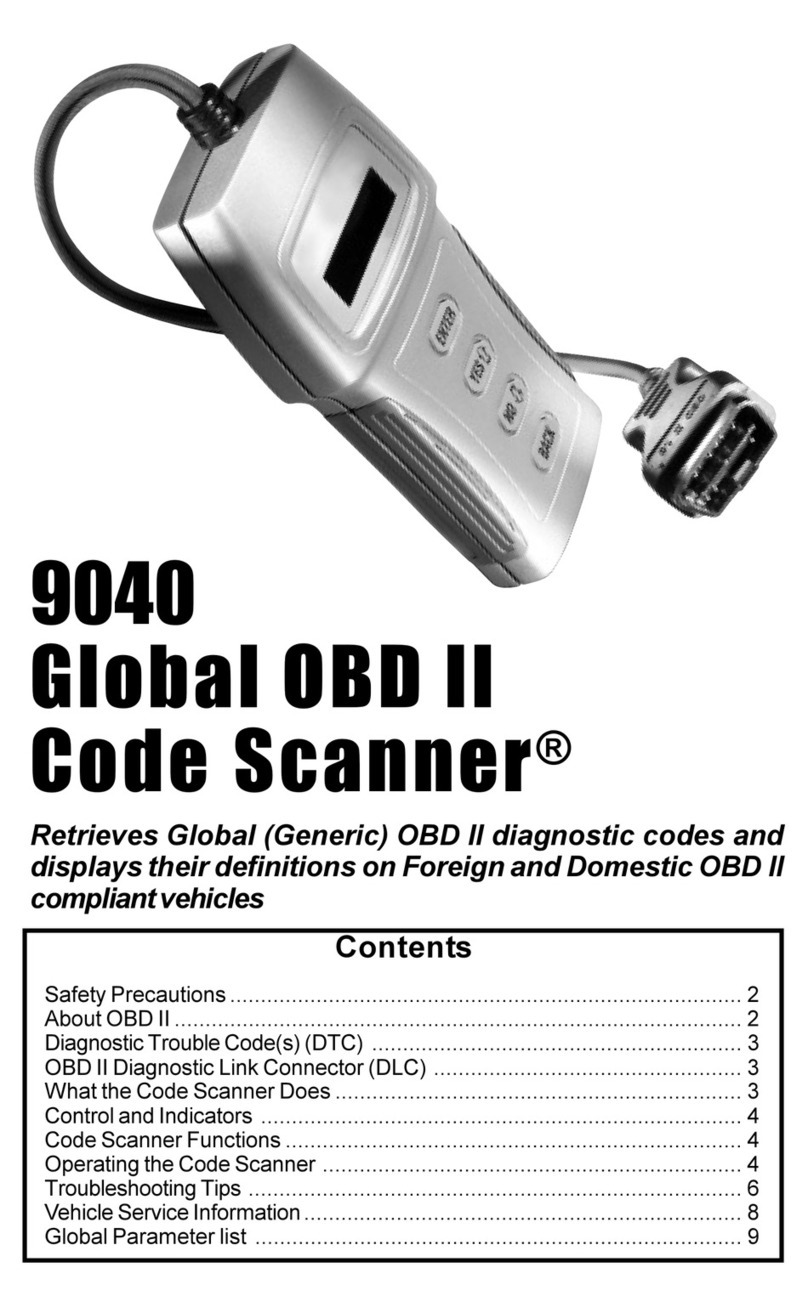
Actron
Actron 9040 User manual

Actron
Actron CP9690 Elite AutoScanner User manual

Actron
Actron CP9180 User manual
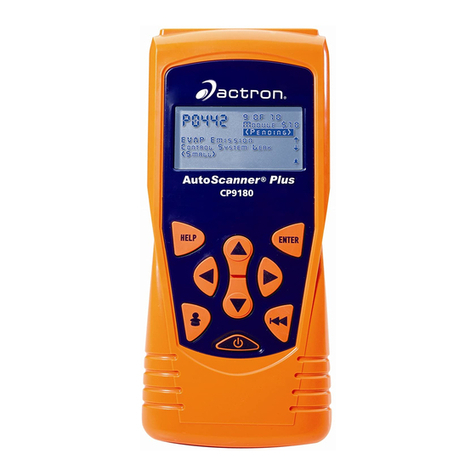
Actron
Actron CP9180 User manual
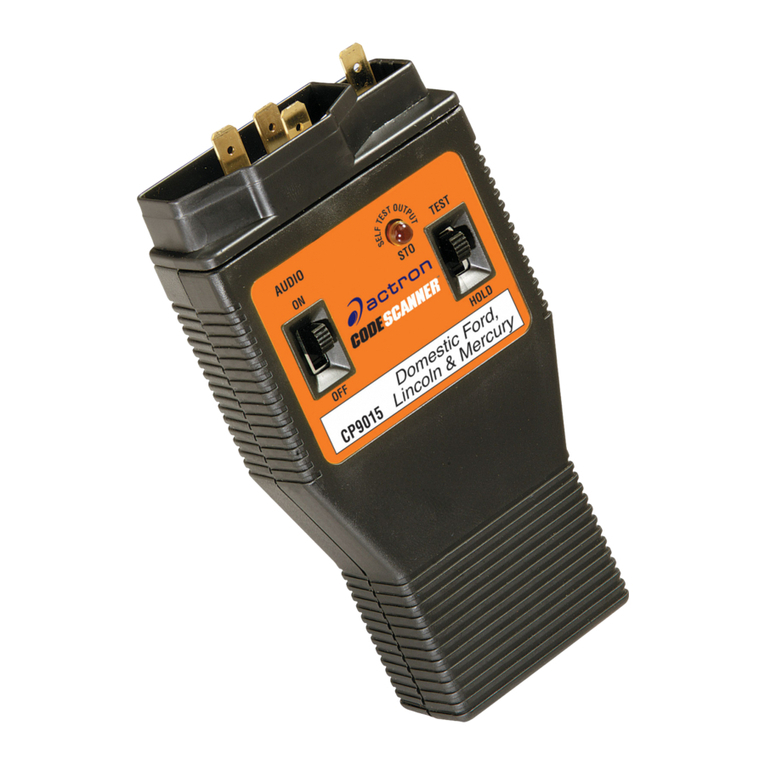
Actron
Actron Code Scanner CP9015 User manual

Actron
Actron CP9680 AutoScanner Plus Technical manual

Actron
Actron Code Scanner CP9015 User manual
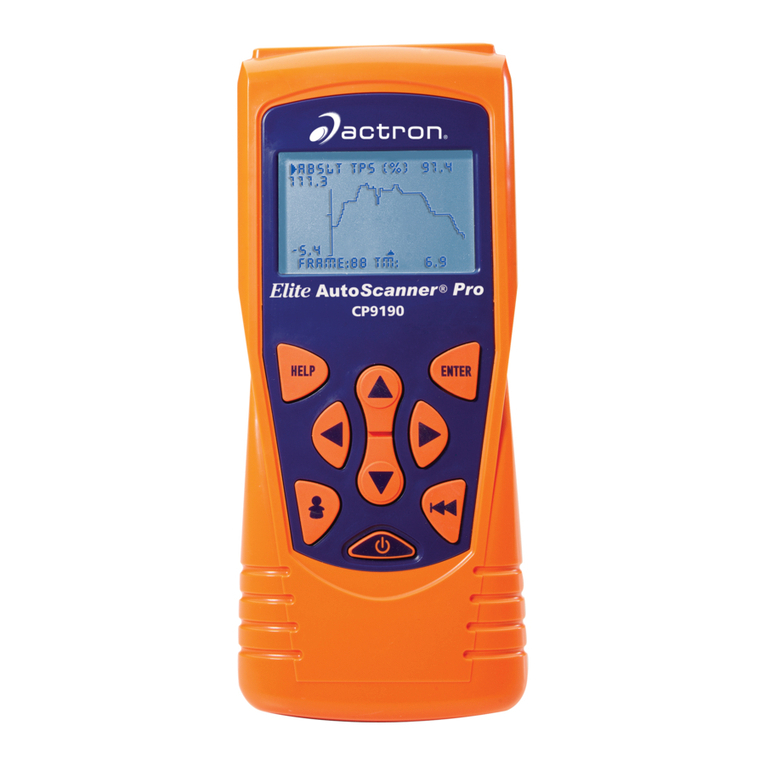
Actron
Actron CP9190 User manual
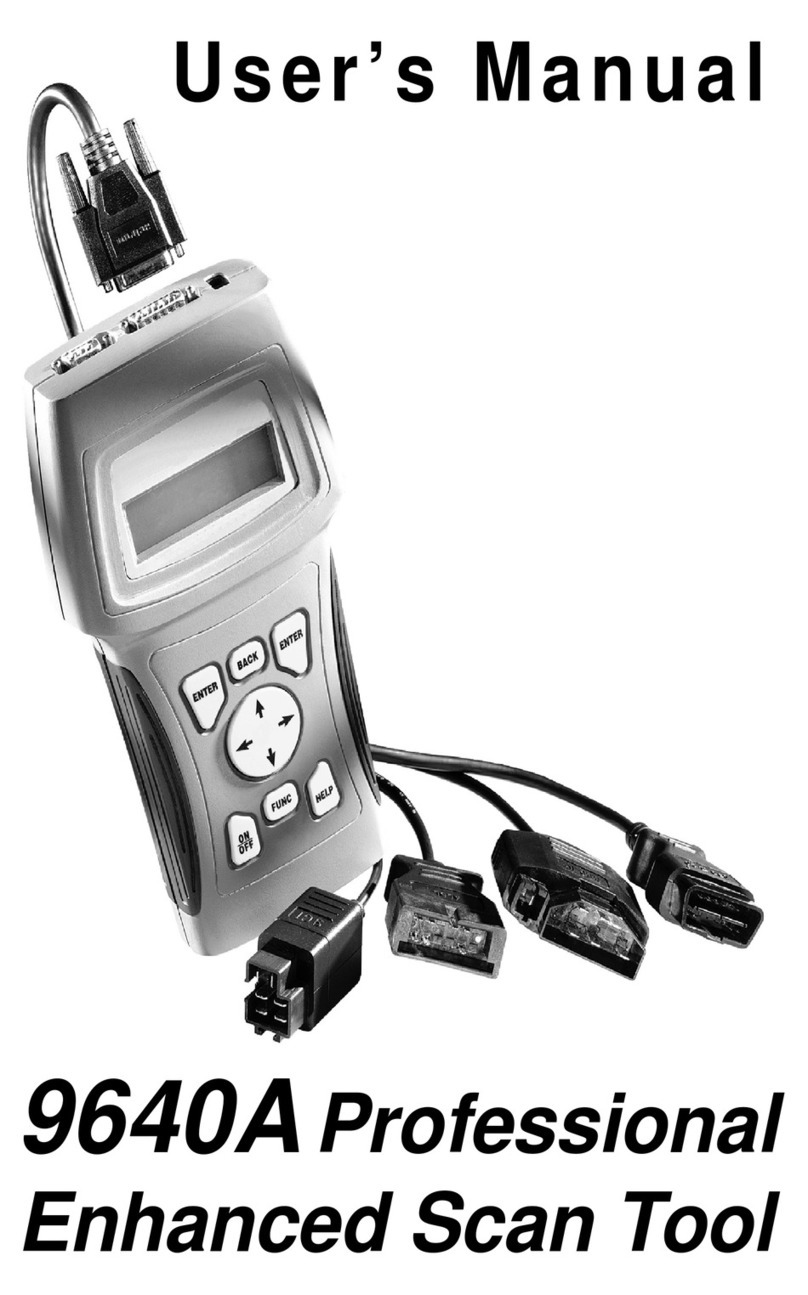
Actron
Actron Professional Enhanced Scan Tool 9640A User manual
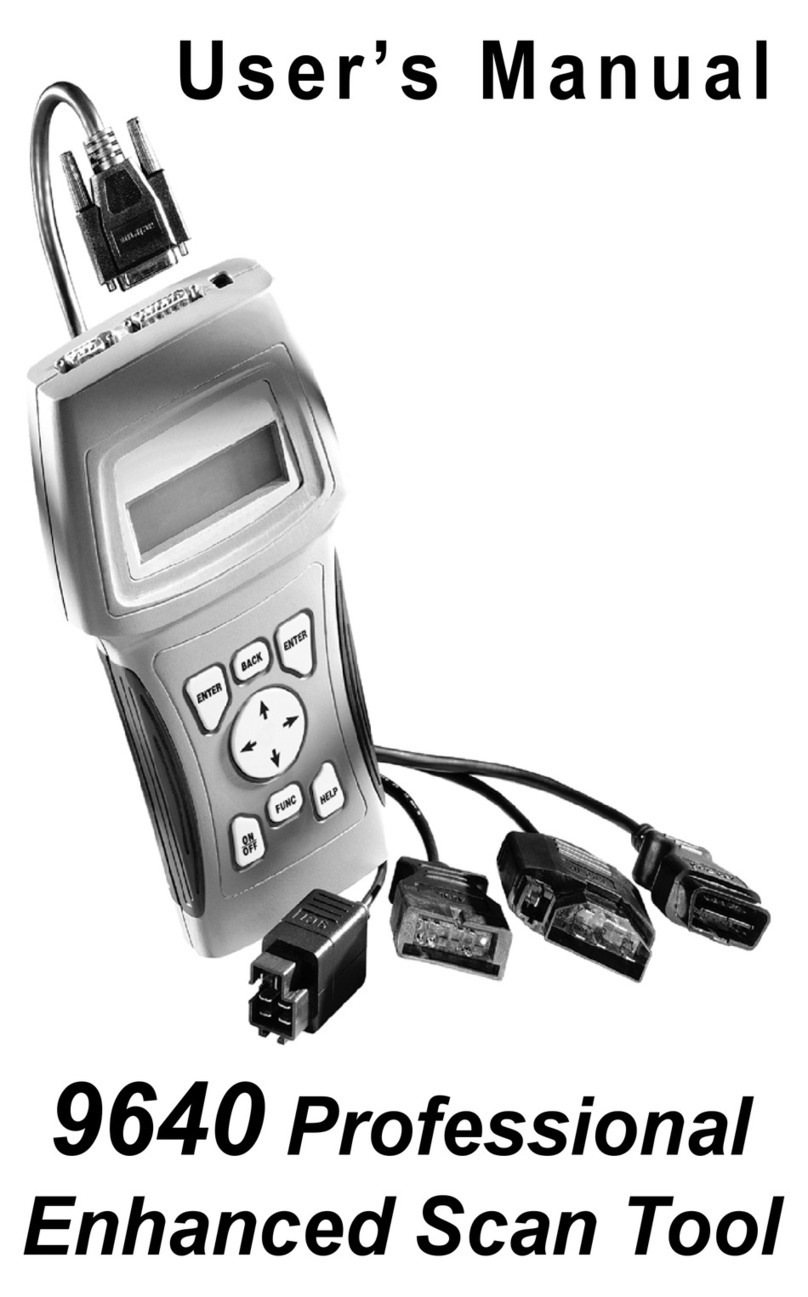
Actron
Actron 9640 User manual
